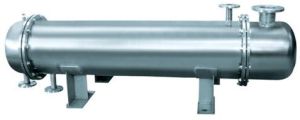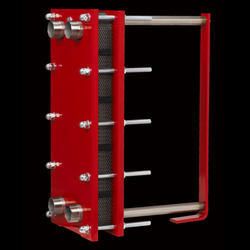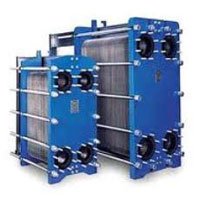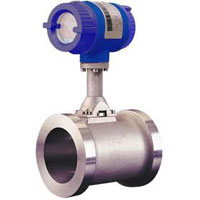
V Thermo Tube Heat Exchanger
Brand Name : V Thermo
Voltage : 230 V
Power : 7.5-110 KW
...more
Three Stage Plate Heat Exchanger
Based in hyderabad (andhra pradesh), we offer premium three stage plate heat exchanger for the clients all across the globe. Our three stage plate heat exchanger is used in sterilization of milk, juice and other liquid food. Three stage plate heat exchanger that we offer can also be used in conjunction with the homogeneous machines. The work order in our three stage plate heat exchanger is preheating, homogenizing, heating and cooling. Three stage plate heat exchanger that we offer can be customized according to the requirements in terms of various technology combinations.specifications flow : 0.5-50th plate material : ss304, ss316l board material : stainless steel package heating medium : steam, hot water cooling medium : ice water, cooling water
...more
Plate Type Pasteurizer
We are offering plate type pasteurizer three-stage plate heat exchanger used in sterilization for milk, juice and other liquid food. plate heat exchanger three stage for pasteurization three-stage plate heat exchanger is mainly used for milk, fruit juice and other liquid food sterilization, can be used in conjunction with the homogeneous machines, the work order is preheating, homogenizing, heating, cooling. Can be customized according to customer requirements of various technology combinations. flow: 0.5-50t/h plate material: ss304, ss316l board material: stainless steel package heating medium: steam, hot water cooling medium: ice water, cooling water
...more
Plate Heat Exchangers
Brand Name : V Thermo
Power : 7.5-110 KW
Voltage : 220 V/380 V
...more
Plate Heat Exchanger Gaskets
We provide high quality Plate Heat Exchanger Gaskets (PHE gaskets) that are purchased from reliable vendors in the market. Our Plate Heat Exchanger Gaskets are manufactured by utilizing advance technology. Plate Heat Exchanger Gaskets that we offer are used for a multitude of heat transfer applications across various industries including chemical, offshore, oil and gas, petrochemicals, power plants, pulp and paper, steel, zinc and aluminum, sugar, vegetable oil, breweries & distilleries, dairy & beverages and many more. Our assortment of Plate Heat Exchanger Gaskets is available for various models of PHE in various M.O.C such as NBR, HNBR, EPDM, butyl, silicon, viton and many more. We supply Plate Heat Exchanger Gaskets to suit several models including glue type, clip on type, nib-on type and more.
...more
Plate Heat Exchanger
We are offering the best quality Plate Heat Exchanger that is a type of heat exchanger which uses metal plates to transfer heat between two fluids. Plate Heat Exchanger that we offer has a major advantage over a conventional heat exchanger as in that the fluids are exposed to a much larger surface area because the fluids spread out over the plates. This facilitates the transfer of heat, and greatly increases the speed of the temperature change. Our Plate Heat Exchanger is now common and its very small brazed versions are used in the hot-water sections of millions of combination boilers. The high heat transfer efficiency for such a small physical size has increased the domestic hot water (DHW) flowrate of combination boilers. Small Plate Heat Exchanger, provided by us, has made a great impact in domestic heating and hot-water. Larger commercial versions of our Plate Heat Exchanger use gaskets between the plates, smaller version tend to be brazed.
...more
Heat Exchanger Plates
We are engaged in supplying and exporting excellent quality Heat Exchanger Plates for the customers. We provide Heat Exchanger Plates of different brands like Alfa Laval, Tranter, GEA, Sondex, Vicarb, APV, etc. Our Heat Exchanger Plates have different MOCS of SS316, SS304, Titanium, Haste alloy C-276, Alloy 59. We have associations with trusted vendors, and hence Heat Exchanger Plates that we provide to the customers are strong and durable.Thickness Of Our Heat Exchanger Plates : 0.5 mm to 0.6 mm
...more
Flow Control Valves
Flow Control Valves that we offer regulate the flow or pressure of a fluid. Flow Control Valves, offered by us, normally respond to signals generated by independent devices such as flow meters or temperature gauges. Our Flow Control Valves are normally fitted with actuators and positioners. Pneumatically-actuated globe valves and diaphragm valves are widely used for control purposes in many industries, although quarter-turn types such as (modified) ball, gate and butterfly valves are also used.Flow Control Valves, offered by us, can also work with hydraulic actuators (also known as hydraulic pilots). These types of valves are also known as Automatic Control Valves. The hydraulic actuators will respond to changes of pressure or flow and will open/close the valve. Automatic Control Valves do not require an external power source, meaning that the fluid pressure is enough to open and close the valve. Automatic control valves include: pressure reducing valves, flow control valves, back-pressure sustaining valves, altitude valves, and relief valves. An altitude valve controls the level of a tank. The altitude valve will remain open while the tank is not full and it will close when the tanks reaches its maximum level. The opening and closing of the valve requires no external power source (electric, pneumatic, or man power), it is done automatically, hence its name.Process plants consist of hundreds, or even thousands, of control loops all networked together to produce a product to be offered for sale. Each of these control loops is designed to keep some important process variable such as pressure, flow, level, temperature, etc. within a required operating range to ensure the quality of the end product. Each of these loops receives and internally creates disturbances that detrimentally affect the process variable, and interaction from other loops in the network provides disturbances that influence the process variable. To reduce the effect of these load disturbances, sensors and transmitters collect information about the process variable and its relationship to some desired set point. A controller, then processes this information and decides what must be done to get the process variable back to where it should be after a load disturbance occurs. When all the measuring, comparing, and calculating are done, some type of final control element must implement the strategy selected by the controller. The most common final control element in the process control industries is the Flow Control Valve. Flow Control Valves manipulate a flowing fluid, such as gas, steam, water, or chemical compounds, to compensate for the load disturbance and keep the regulated process variable as close as possible to the desired set point.
...more
Heat Exchangers

Industrial Gaskets

Valve Plates

Industrial Heat Exchangers

Flow Meters
Be first to Rate
Rate ThisOpening Hours